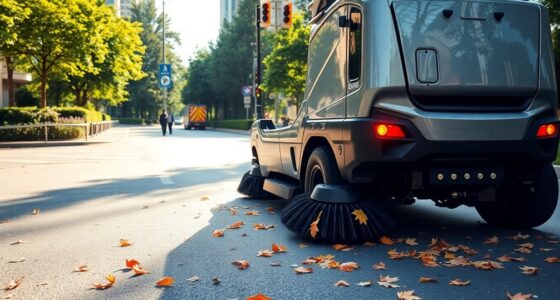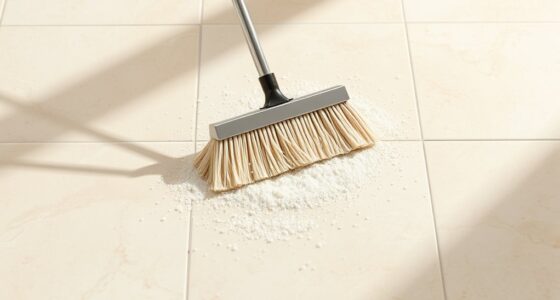To keep your industrial sweeper machine running smoothly, start with daily pre-use checks like inspecting lights and brakes. Establish a regular maintenance schedule based on usage to ensure timely upkeep. Implement preventive measures, such as cleaning filters and lubricating moving parts. Don't forget to optimize performance by checking squeegee blades and brushes regularly. Incorporate technology for maintenance tracking and keep detailed logs for accountability. There's more to explore to enhance your equipment's efficiency and longevity.
Key Takeaways
- Regularly inspect safety features, including lights and brakes, to ensure proper functionality before operating the sweeper.
- Maintain a detailed maintenance log to track activities and identify recurring issues for early resolution.
- Schedule routine inspections and preventive maintenance based on usage patterns to reduce downtime and repair costs.
- Keep the sweeper clean by removing debris and lubricating moving parts to enhance performance and longevity.
- Train staff on proper operation techniques to minimize wear and tear on the equipment and ensure safety.
Importance of Pre-Use Checks
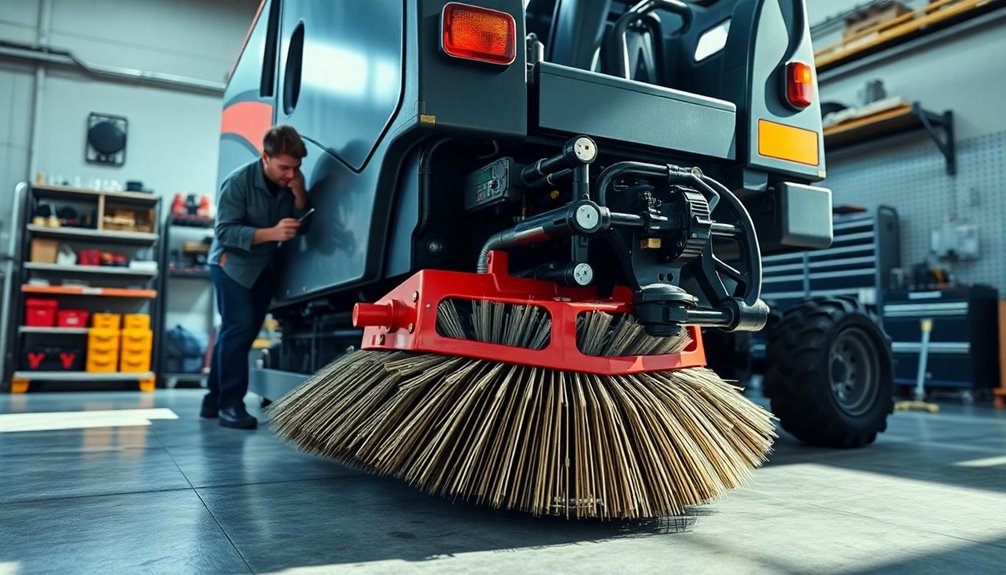
Before you start operating an industrial sweeper, it's crucial to perform pre-use checks to ensure safety, performance, and efficiency.
First, inspect safety features like lights and brakes; make sure everything's working properly. Check electrical connections for wear and test warning systems, including alarms and emergency stops, to keep yourself safe.
Next, evaluate the brushes and squeegee blades for damage, and clear any debris blocking the vacuum hose. It's also important to check fuel level or battery charge indicator to ensure reliable operation.
Verify fluid levels for hydraulic systems and the battery condition to ensure reliable operation.
Finally, remove any debris from the machine bed and ensure all moving parts are properly lubricated.
These pre-use checks play a vital role in maintaining the longevity and effectiveness of your industrial sweeper.
Establishing a Regular Maintenance Schedule
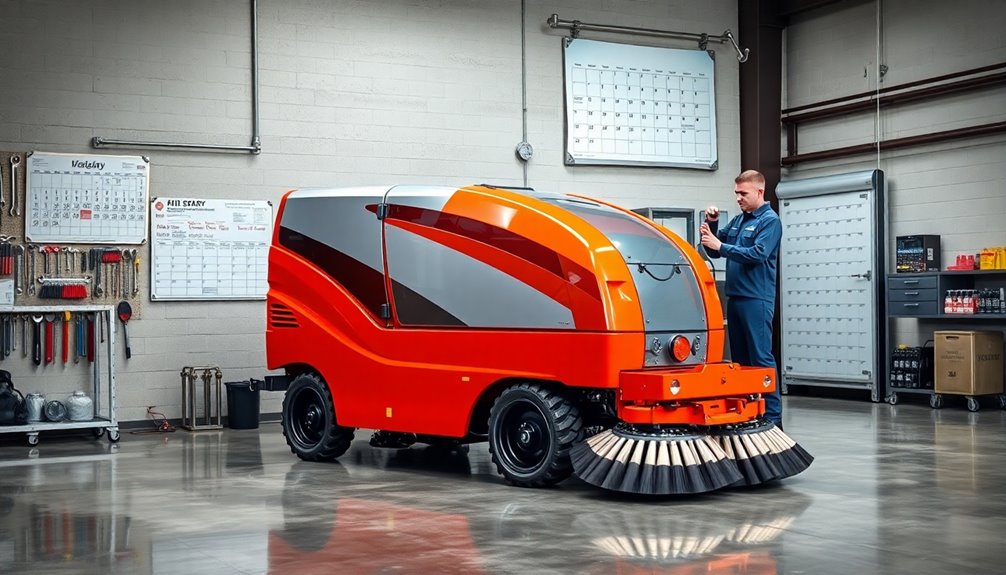
Establishing a regular maintenance schedule is essential for keeping your industrial sweeper in optimal condition.
Start by creating a maintenance calendar tailored to your machine's usage patterns. Set maintenance intervals according to the manufacturer's manual and adjust based on how often you use the machine. Periodic maintenance should be scheduled with an authorized technician at least once a year or after 250 hours of work.
Consider seasonal variations that may affect its needs. Leverage technology by implementing maintenance software to track history, set reminders, and monitor parts inventory, ensuring you never run short.
Document all maintenance activities in detail, noting repairs and issues to identify recurring problems. Regularly review and update your schedule to keep it relevant and effective.
This proactive approach will enhance your sweeper's performance and longevity.
Implementing Preventive Measures

Implementing preventive measures is crucial for maximizing the efficiency and lifespan of your industrial sweeper. Start by adopting a maintenance strategy that suits your operation, whether it's usage-based, time-based, condition-based, or predictive maintenance.
Regularly inspect vital components like engine fluids, tire pressure, and lights, and check for any damage or wear on hoses and filters. Don't overlook routine tasks like cleaning or replacing filters and lubricating moving parts.
Preventive maintenance helps catch potential issues before they escalate, ultimately saving you money and extending the equipment's life. Keep detailed records of all maintenance activities and develop a solid budget for repairs. Assign specific personnel to handle these tasks and review your maintenance plan regularly.
Optimizing Machine Performance
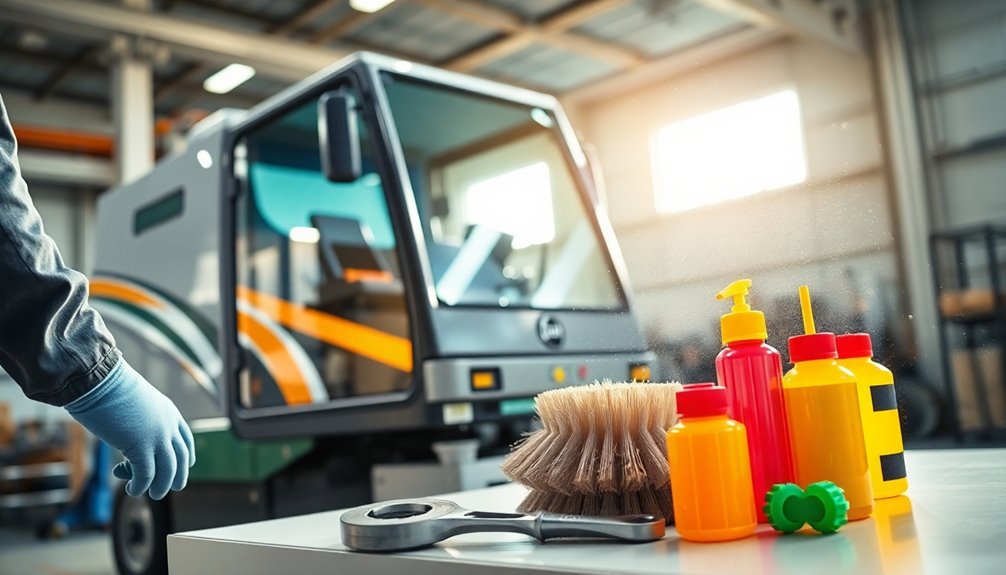
To get the most out of your industrial sweeper, optimizing machine performance is key. Start by adjusting speed settings; aim for a cleaning speed of about 5.27 km/h, with roller brush speeds at 159.86 r/min and disk brush speeds at 106.85 r/min for maximum efficiency.
Regularly inspect and replace worn brushes or pads to maintain optimal cleaning. Ensure the squeegee blade is in good condition, as this prevents inefficiencies. Always begin with a fully charged battery to enhance performance.
Implement a consistent cleaning schedule and lubricate moving parts to reduce wear and tear. Additionally, performing regular machine inspections can help catch issues early and prevent costly breakdowns. Finally, analyze machine performance data to identify trends and make informed adjustments, ensuring you consistently achieve high cleaning rates under optimal conditions.
Key Safety Considerations
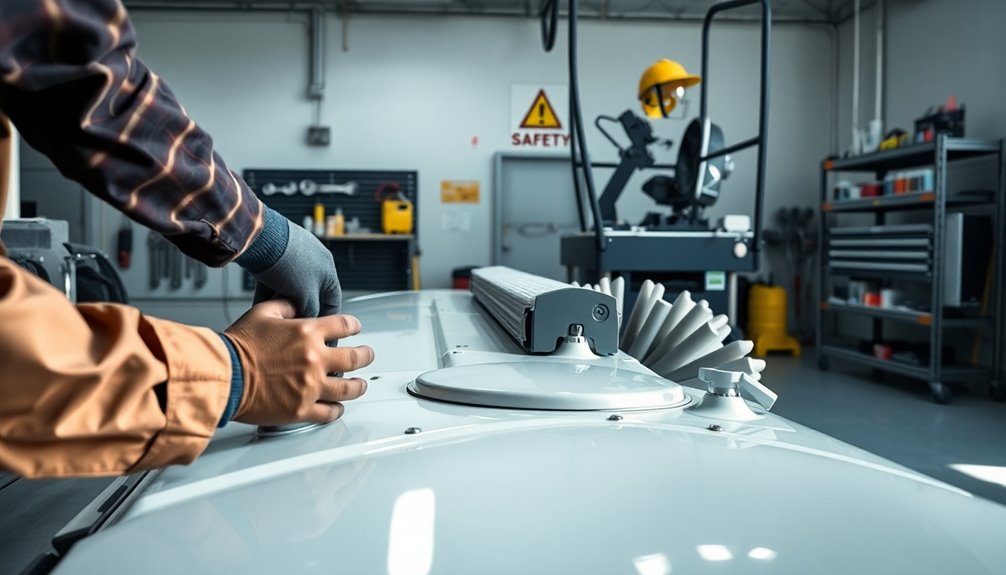
When operating industrial sweepers, understanding key safety considerations is crucial for preventing accidents and ensuring a safe working environment.
Always avoid using flammable materials nearby, and handle chemicals according to instructions. Keep the water temperature below 60°C (140°F) to prevent injury or damage. Only use manufacturer-approved attachments to maintain machine integrity, and ensure a safe distance from the operating area to avoid collisions.
Wear appropriate personal protective equipment, like safety goggles and non-slip shoes, and avoid loose clothing that could get caught in moving parts. Additionally, maintaining clean floors reduces the risk of slips, trips, and falls, enhancing overall safety.
Regularly inspect the machine for excessive vibration or damage, and check brake and steering functionality.
Lastly, keep ignition sources away from batteries and properly dispose of wastewater to maintain safety for everyone.
Long-Term Maintenance Planning
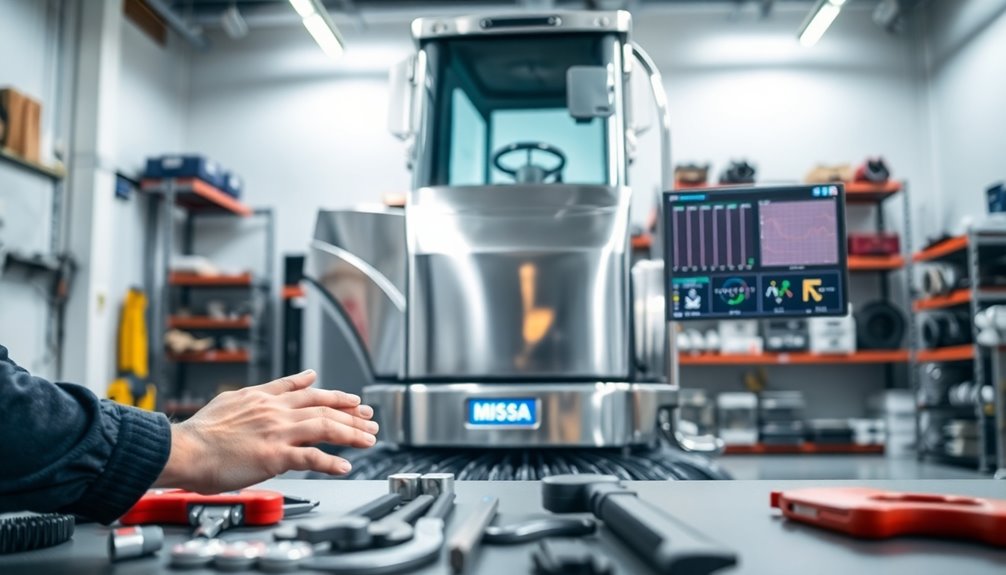
Effective long-term maintenance planning is essential for maximizing the lifespan and performance of your industrial sweeper.
Start by conducting daily visual inspections to spot wear and tear on brushes, belts, and hoses. Regular lubrication of moving parts reduces friction and prevents overheating. Well-maintained street sweepers are crucial for ensuring consistent and high-quality cleaning performance.
After each use, clean the sweeper thoroughly, empty the hopper, and maintain filters for optimal airflow. Stick to the manufacturer's maintenance schedule for oil changes and fluid checks, and consider professional servicing to catch potential issues early.
Keep a detailed log of maintenance activities to track your machine's history.
Effective Training for Operators

While operators may know how to operate industrial sweepers, comprehensive training ensures they fully understand the equipment and its maintenance requirements.
A well-rounded training program covers equipment anatomy, safe operations, and maintenance procedures. Hands-on training is crucial, allowing you to gain real-world experience and improve efficiency. Emphasizing safety protocols helps prevent injuries and ensures compliance with regulations. OSHA-aligned training enhances the effectiveness of operator training by providing standardized safety practices.
Regular refresher courses keep your skills sharp and help you adapt to new technologies. Training should include pre-trip inspections, operational techniques, and troubleshooting skills.
Performance assessments and feedback mechanisms ensure you continually improve. Remember, pairing with experienced mentors can enhance your learning and help you master best practices effectively.
Certification upon completion boosts your confidence and competency in operating the machinery.
Technology Integration for Maintenance
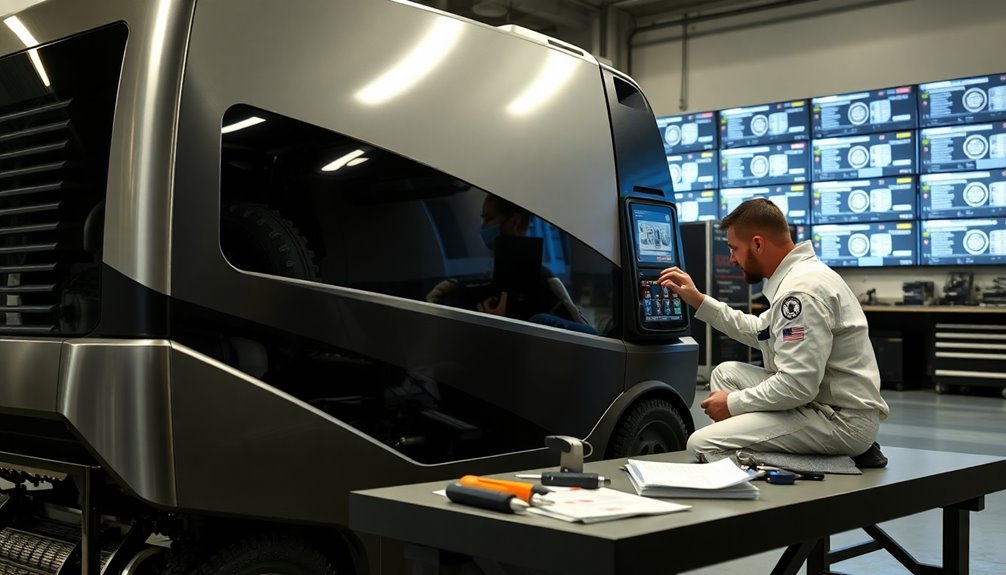
Operator training sets the foundation for effective equipment management, but integrating technology takes maintenance to the next level.
Utilizing IoT and sensors, you can monitor your sweeper's health, identifying potential issues before they lead to failures. Real-time data collection provides insights into performance, enabling you to optimize both maintenance and operations. The integration of advanced filtration systems ensures that your sweeper operates within environmental standards, further enhancing its efficiency.
Predictive maintenance driven by data analytics forecasts repair needs, significantly reducing unplanned downtime. AI and automation enhance your sweeper's efficiency, lessening the need for manual intervention.
Implementing cloud-based management systems allows you to track fleet status and control operations remotely.
Cost Management Strategies
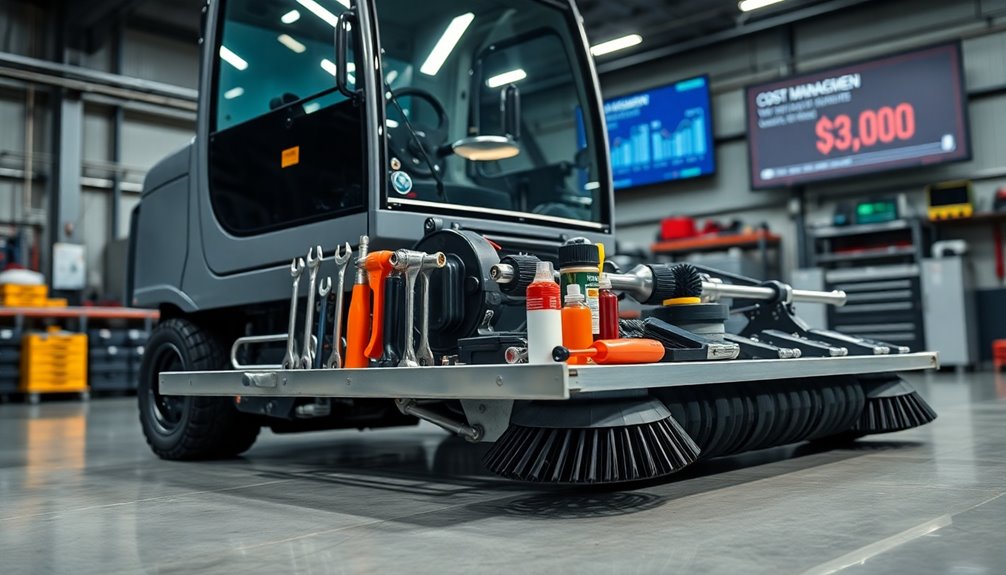
Managing costs effectively is crucial for maximizing the value of your industrial sweeper. Start by conducting a lifecycle cost analysis to understand the total cost of ownership, including acquisition and disposal. Lifecycle cost analysis helps fleet managers understand annual costs of operating sweepers, guiding your financial decisions. Additionally, consider the potential for inflation-protected annuities to secure your financial future against rising costs.
Gather detailed data on fuel, maintenance, and labor expenses to inform your budget. Establish a comprehensive budget that prepares you for all related expenses.
Compare costs of different models and maintenance strategies to find the most cost-effective options. Don't forget to consider the residual value of your sweeper at the end of its lifecycle.
Implement preventive maintenance strategies to reduce downtime and repair costs. Finally, renegotiate service contracts for better pricing, ensuring your operations remain financially sustainable while maintaining performance.
Importance of Maintenance Logs
Effective cost management lays the groundwork for successful industrial operations, but it's just as important to maintain detailed maintenance logs for your equipment.
These logs enhance asset longevity by tracking minor issues, helping you address them before they escalate. Regular updates ensure operational efficiency, reducing downtime and keeping your sweeper running optimally. In addition, comprehensive logs are essential in meeting standards set by regulatory bodies, aiding in audits.
They're crucial for regulatory compliance, making audits a breeze. Additionally, informed decision-making becomes easier when you analyze performance data from your logs.
They also promote safety by documenting necessary checks, ensuring accountability among your maintenance team. By implementing best practices like digital storage and standardized formats, you streamline the entire process, enhancing transparency and paving the way for effective predictive maintenance strategies.
Frequently Asked Questions
How Can I Tell if My Sweeper Needs Repairs?
You can tell if your sweeper needs repairs by watching for signs like decreased performance, unusual noises, or leaks.
If you notice vibrations or shaking during operation, it's a red flag.
Also, keep an eye on battery life; shorter run times might mean issues with the battery or connections.
Regularly check the brushes and suction motor to ensure they're functioning properly, as these can significantly impact your sweeper's effectiveness.
What Are Common Signs of Wear on Scrubbing Brushes?
You might think scrubbing brushes are invincible, but they wear down just like your favorite pair of shoes.
Keep an eye out for bristle loss, frayed edges, and discoloration. If you notice reduced cleaning efficiency or visible damage, it's time for a change.
Regular inspections can help catch these issues early, ensuring your brushes stay effective and your cleaning tasks don't turn into a messy nightmare.
Don't let worn brushes ruin your efforts!
How Often Should I Replace the Squeegee Blade?
You should replace the squeegee blade every 100-150 hours of use, but if you're in a high-demand environment, consider daily replacements or flipping the blade to extend its life.
Keep an eye on the blade's performance; if it's leaving streaks or not picking up water effectively, it's time for a change.
Additionally, the type of job and the size of the blade can impact how often you need to replace it.
What Cleaning Agents Are Safe for the Solution Tank?
So, you're thinking of using magical potions for your solution tank? Well, hold your unicorns!
Stick to biodegradable, non-toxic cleaning agents instead. Look for those that are VOC-free and non-flammable, ensuring a safe workspace.
Opt for low aquatic toxicity options to protect our fishy friends. And hey, make sure they're non-corrosive!
Your tank will thank you, and you'll avoid transforming your equipment into a rusty relic of the past.
Can I Use My Sweeper on Uneven Surfaces?
Yes, you can use your sweeper on uneven surfaces.
Many industrial sweepers are designed with features like adjustable brush height and robust construction to handle rough terrain effectively.
Just make sure to inspect your machine beforehand and adjust the settings to match the surface conditions.
Operating at safe speeds will help you navigate obstacles without damaging the sweeper or the surface.
Regular maintenance will keep your sweeper performing well in these challenging environments.
Conclusion
By keeping your industrial sweeper in top shape, you're not just maintaining a machine; you're ensuring a clean, efficient workspace that echoes the legendary diligence of Hercules. Regular checks and a solid maintenance schedule are your golden fleece, protecting your investment and enhancing performance. Remember, a well-maintained sweeper not only saves you money but also keeps your team safe. So, embrace these tips, and watch as your machine transforms your environment like magic.


